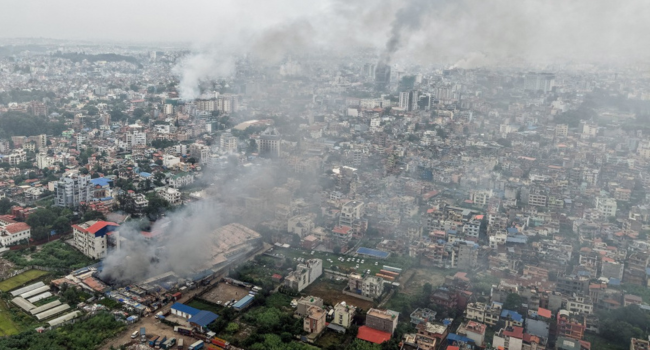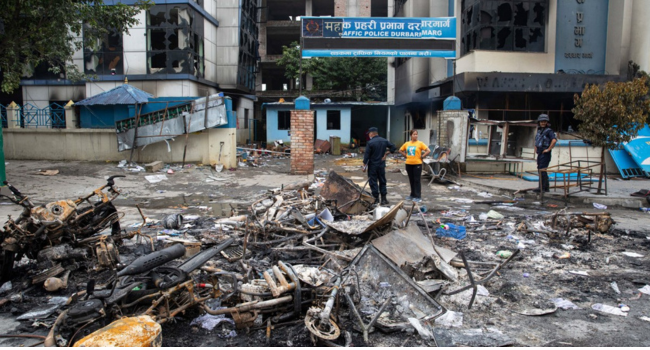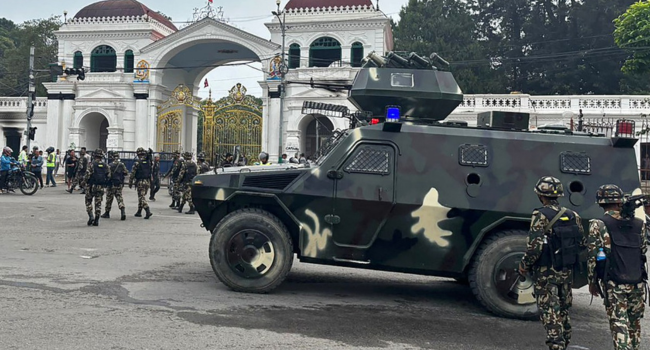Nepali soldiers patrolled the streets of Kathmandu on Wednesday, seeking to restore order after protesters set parliament ablaze and forced the prime minister to quit in the worst violence to hit the Himalayan nation in two decades.
Read more: Nepal Army Bids To Restore Order After Deadly Protests Oust PMProtests had began Monday in the Nepali capital against the government’s ban on social media and over corruption, but escalated into an outpouring of rage nationwide with government buildings set on fire after a deadly crackdown claimed at least 19 lives.
The rapid descent into chaos shocked many, and Nepal’s military warned against activities that could lead the country into unrest and instability in the country of 30 million people.
Soldiers issued orders via loudspeakers on the streets, as tanks rumbled past the carcasses of burnt vehicles and tyres.
The army warned Wednesday that vandalism, looting, arson, or attacks on individuals and property in the name of protest will be treated as punishable crimes.
Kathmandu’s airport is expected to resume operations later on Wednesday at 6:00 pm (1215 GMT), manager Hansa Raj Pandey told Nepali media.

Plumes of smoke engulf the city of Kathmandu on September 10, 2025, a day after several buildings were set ablaze by protesters. Nepali demonstrators set parliament ablaze on September 9, while the veteran prime minister quit, as a “Gen Z” protest movement sparked by a ban on social media overtook the Himalayan nation. At least 19 people were killed during rallies a day earlier, one of the deadliest crackdowns in years, which fuelled public anger. (Photo by PRABIN RANABHAT / AFP)
Smouldering plumes of smoke rose from the government buildings, residences of politicians, supermarkets and other buildings targeted by protesters, an AFP reporter said Wednesday.Firefighters doused remaining blazes, including at the tower block of the key Kantipur media group.
It is quiet today, the army is on the streets in all places, one soldier inspecting cars at a makeshift street checkpoint said, who could not be named as he was not authorised to speak to reporters.
Gangs on Tuesday had attacked and set fire to the house of KP Sharma Oli, the 73-year-old, four-time prime minister and leader of the Communist Party.
He later quit to allow “steps towards a political solution”. His whereabouts are not known.
– ‘Call it off’ –

Men look at the remains and ravages of a charred police station in Kathmandu on September 10, 2025. Nepali demonstrators set parliament ablaze on September 9, while the veteran prime minister quit, as a “Gen Z” protest movement sparked by a ban on social media overtook the Himalayan nation. At least 19 people were killed during rallies a day earlier, one of the deadliest crackdowns in years, which fuelled public anger. (Photo by PRABIN RANABHAT / AFP)
Nepali Army chief, General Ashok Raj Sigdel, has appealed for talks in a video message issued late Tuesday.
To provide the nation with a peaceful resolution, we urge all groups involved in the protest to call it off and engage in dialogue, he said.
The International Crisis Group called it a major inflection point in the country’s uneasy experience with democratic rule.
United Nations Secretary-General Antonio Guterres has urgedrestraint to avoid a further escalation of violence, his spokesman Stephane Dujarric said in a statement.
Prime Minister Narendra Modi of neighbouring India said that the stability, peace and prosperity of Nepal are of utmost importance to us.
What happens next is unclear.
The protesters, leaders who are trusted by them and the army should come together to pave the way for a caretaker government, constitutional lawyer Dipendra Jha told AFP.
Crisis Group analyst Ashish Pradhan echoed that, saying a transitional arrangement will now need to be charted out swiftly and include figures who still retain credibility with Nepalis, especially the country’s youth.
But with the speed of the youth-led uprising, it remained unclear who the young protesters will mobilise behind to lead the country out of the political vacuum.
People aged 15-40 make up nearly 43 percent of the population, according to government statistics — while unemployment hovers around 10 percent and GDP per capita is just $1,447, according to the World Bank.
Several social media sites — including Facebook, YouTube, and X — were blocked on Friday, after the government cut access to 26 unregistered platforms.
Since then, videos contrasting the struggles of ordinary Nepalis with the children of politicians flaunting luxury goods and expensive vacations have gone viral on TikTok, which was not blocked.
AFP








